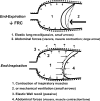Perioperative medical management of patients with COPD
- PMID: 18268924
- PMCID: PMC2699974
Perioperative medical management of patients with COPD
Abstract
Chronic obstructive pulmonary disease (COPD) and heart diseases are considered independent risk factors for mortality and major cardiopulmonary complications after surgery. Coronary artery disease, heart failure and COPD share common risk factors and are often encountered,--isolated or combined--, in many surgical candidates. Perioperative optimization of these high-risk patients deserves a thorough understanding of the patient cardiopulmonary diseases as well as the respiratory consequences of surgery and anesthesia. In contrast with cardiac risk stratification where the extent of heart disease largely influences postoperative cardiac outcome, surgical-related factors (ie, upper abdominal and intra-thoracic procedures, duration of anesthesia, presence of a nasogastric tube) largely dominate patient's comorbidities as risk factors for postoperative pulmonary complications. Although most COPD patients tolerate tracheal intubation under "smooth" anesthetic induction without serious adverse effects, regional anesthetic blockade and application of laryngeal masks or non-invasive positive pressure ventilation should be considered whenever possible, in order to provide optimal pain control and to prevent upper airway injuries as well as lung baro-volotrauma. Minimally-invasive procedures and modern multimodal analgesic regimen are helpful to minimize the surgical stress response, to speed up the physiological recovery process and to shorten the hospital stay. Reflex-induced bronchoconstriction and hyperdynamic inflation during mechanical ventilation could be prevented by using bronchodilating volatile anesthetics and adjusting the ventilatory settings with long expiration times. Intraoperatively, the depth of anesthesia, the circulatory volume and neuromuscular blockade should be assessed with modem physiological monitoring tools to titrate the administration of anesthetic agents, fluids and myorelaxant drugs. The recovery of postoperative lung volume can be facilitated by patient's education and empowerment, lung recruitment maneuvers, non-invasive pressure support ventilation and early ambulation.
Figures
References
-
- Alvisi V, Romanello A, Badet M, et al. Time course of expiratory flow limitation in COPD patients during acute respiratory failure requiring mechanical ventilation. Chest. 2003;123:1625–32. - PubMed
-
- [Anon] Practice advisory for preanesthesia evaluation: a report by the American Society of Anesthesiologists Task Force on Preanesthesia Evaluation. Anesthesiology. 2002;96:485–96. - PubMed
-
- [Anon] Practice advisory for intraoperative awareness and brain function monitoring: a report by the american society of anesthesiologists task force on intraoperative awareness. Anesthesiology. 2006;104:847–64. - PubMed
-
- Arieff AI. Fatal postoperative pulmonary edema: pathogenesis and literature review. Chest. 1999;115:1371–7. - PubMed
Publication types
MeSH terms
LinkOut - more resources
Full Text Sources
Medical



